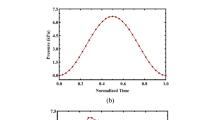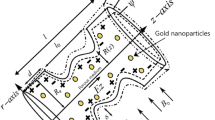Abstract
Arterial aneurysms are in a pre-deformed state in vivo under non-zero pressure. The ability to determine their zero pressure geometry may help in improving accuracy of determination of stress distribution and reverse estimation of material properties from dynamic imaging data. An approximate method to recover the zero pressure geometry of the AAA is proposed. This method is motivated by the observation that the patterns in displacement field for a given AAA are strikingly consistent in an AAA under all physiological pressures. The basic principle is to leverage this observation to iteratively identify the geometry that when subjected to the in vivo pressure, will recover the geometry reconstructed from in vivo imaging. The methodology is demonstrated and validated using patient-specific AAA models.






Similar content being viewed by others
REFERENCES
Di Martino, E. S., G. Guadagni, A. Fumero, G. Ballerini, R. Spirito, P. Biglioli, and A. Redaelli. Fluid-structure interaction within realistic three-dimensional models of the aneurysmatic aorta as a guidance to assess the risk of rupture of the aneurysm. Med. Eng. Phys. 23(9):647–55, 2001.
Fillinger, M. F., S. P. Marra, M. L. Raghavan, and F. E. Kennedy. Prediction of rupture risk in abdominal aortic aneurysm during observation: Wall stress versus diameter. J. Vasc. Surg. 37(4):724–32, 2003.
Fillinger, M. F., M. L. Raghavan, S. P. Marra, J. L. Cronenwett, and F. E. Kennedy. in vivo analysis of mechanical wall stress and abdominal aortic aneurysm rupture risk. J. Vasc. Surg. 36(3):589–97, 2002.
Raghavan, M. L., D. A. Vorp, M. P. Federle, M. S. Makaroun, and M. W. Webster. Wall stress distribution on three-dimensionally reconstructed models of human abdominal aortic aneurysm. J. Vasc. Surg. 31(4):760–9, 2000.
Thubrikar, M. J., J. al-Soudi, and F. Robicsek. Wall stress studies of abdominal aortic aneurysm in a clinical model. Ann. Vasc. Surg. 15(3):355–66, 2001.
Wang, D. H., M. S. Makaroun, M. W. Webster, and D. A. Vorp. Effect of intraluminal thrombus on wall stress in patient-specific models of abdominal aortic aneurysm. J. Vasc. Surg. 36(3):1–7, 2002.
Raghavan, M. L., M. F. Fillinger, S. P. Marra, B. P. Naegelein, and F. E. Kennedy. Automated methodology for determination of stress distribution in human abdominal aortic aneurysm. J. Biomech. Eng. 127(5):868–71, 2005.
Raghavan, M. L., M. F. Fillinger, S. P. Marra, B. P. Naegelein, and F. E. Kennedy. Automated methodology for determination of stress distribution in human abdominal aortic aneurysm. J. Biomech. Eng. in press, 2005.
Raghavan, M. L. and D. A. Vorp. Toward a biomechanical tool to evaluate rupture potential of abdominal aortic aneurysm: Identification of a finite strain constitutive model and evaluation of its applicability. J. Biomech. 33(4):475–82, 2000.
Vorp, D. A., W. A. Mandarino, M. W. Webster, and J. Gorcsan, Third potential influence of intraluminal thrombus on abdominal aortic aneurysm as assessed by a new non-invasive method. Cardiovasc. Surg. 4(6):732–9, 1996.
Marra, S. P., M. L. Raghavan, D. R. Whittaker, M. F. Fillinger, D. Chen, J. M. Dwyer, M. J. Tsapakos, and F. E. Kennedy. Estimation of the zero-pressure geometry of abdomimal aortic aneurysms from dynamic magnetic resonance imaging. in 2005 Summer Bioengineering Conference. 2005. Vail, CO.
Ma, B., J. Lu, R. E. Harbaugh, and M. L. Raghavan. Modeling the geometry, hemodynamics and tissue mechanics of cerebral aneurysms. in 2004 ASME International Mechanical Engineering Congress and Exposition. 2004. Anaheim, CA.
Lu, J., X. Zhou, and M. L. Raghavan. Inverse Elastostatic Stress Analysis in Pre-deformed Biological Structures: Demonstration Using Abdominal Aortic Aneurysms. J Biomech, in press, 2006.
ACKNOWLEDGMENTS
This study was supported in part by NHLBI NIH R01 HL64351-01: The Role Of Wall Stress Distribution In Abdominal Aortic Aneurysms (to MFF).
Author information
Authors and Affiliations
Corresponding author
Rights and permissions
About this article
Cite this article
Raghavan, M.L., Ma, B. & Fillinger, M.F. Non-Invasive Determination of Zero-Pressure Geometry of Arterial Aneurysms. Ann Biomed Eng 34, 1414–1419 (2006). https://doi.org/10.1007/s10439-006-9115-7
Received:
Accepted:
Published:
Issue Date:
DOI: https://doi.org/10.1007/s10439-006-9115-7




